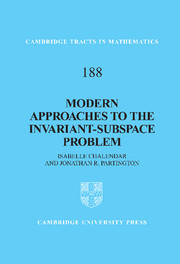Book contents
- Frontmatter
- Contents
- Preface
- 1 Background
- 2 The operator-valued Poisson kernel and its applications
- 3 Properties (An,m) and factorization of integrable functions
- 4 Polynomially bounded operators with rich spectrum
- 5 Beurling algebras
- 6 Applications of a fixed-point theorem
- 7 Minimal vectors
- 8 Universal operators
- 9 Moment sequences and binomial sums
- 10 Positive and strictly-singular operators
- References
- Index
9 - Moment sequences and binomial sums
Published online by Cambridge University Press: 07 October 2011
- Frontmatter
- Contents
- Preface
- 1 Background
- 2 The operator-valued Poisson kernel and its applications
- 3 Properties (An,m) and factorization of integrable functions
- 4 Polynomially bounded operators with rich spectrum
- 5 Beurling algebras
- 6 Applications of a fixed-point theorem
- 7 Minimal vectors
- 8 Universal operators
- 9 Moment sequences and binomial sums
- 10 Positive and strictly-singular operators
- References
- Index
Summary
This chapter treats two fairly self-contained ideas. Moment sequences, which can be defined as the integrals of successive powers of the independent variable with respect to a positive Borel measure on the real line, appear in many mathematical contexts, including probability theory and other branches of analysis. We begin with the idea of a moment sequence that can be associated with powers of an operator, and show how this leads to a proof of the existence of invariant subspaces. Initially, the Banach spaces involved will be either real or complex, but later some of the results we present will be appropriate only for real sequence spaces; we then employ a trick to handle certain operators (in particular, tridiagonal operators) on complex spaces.
Next, we explore a variety of themes concerned with sequences defined in terms of specific formulae involving binomial coefficients. We start with some apparently elementary results about such sequences, linking these to results from complex analysis in the form of various Phragmén–Lindelöf principles. Finally, we arrive at some applications, first to the theory of Banach algebras, and then to the existence of invariant subspaces. This particular subject appears to us to be one where interesting techniques have been introduced but not fully exploited: that is to say, we think that further developments will be possible.
Moment sequences
Definition 9.1.1 Let χ be a separable Banach space, and T ∈ ℒ(χ).
- Type
- Chapter
- Information
- Modern Approaches to the Invariant-Subspace Problem , pp. 233 - 254Publisher: Cambridge University PressPrint publication year: 2011

